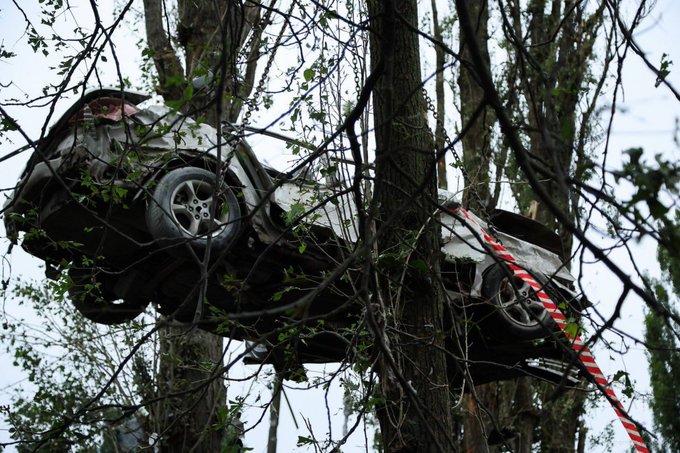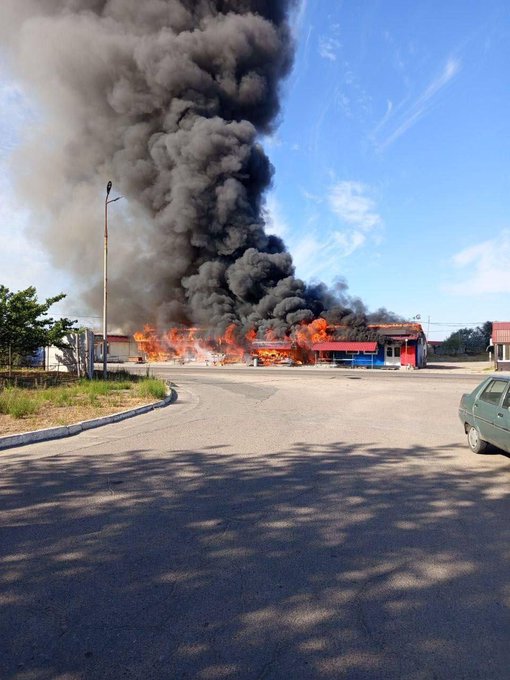Rakete od par miliona $ kao jedina odbrana od dronova od 20-50k.
Russia’s Jet Powered Shahed Kamikaze Drone Is A Big Problem For Ukraine
The altitude and speed at which the drones fly makes them far more difficult to shoot down, requiring increasingly scarce higher-performance SAMs.
Howard Altman
Jul 31, 2025 3:03 PM EDT
Iranian State Media
The TWZ Newsletter
A
deadly Russian attack on Kyiv and other cities overnight included the use of
the jet-powered variant of the Shahed drone, several Ukrainian officials said. The strike highlighted growing concerns that these weapons are harder to track and intercept than propeller-driven Shaheds because of how fast and high they fly. Until alternatives are found, these drones will require Ukraine to use expensive and precious surface-to-air missiles (SAMs) that can cost millions apiece. This looming challenge is something we predicted in detail last year, which you can read more about
here.
The attack included eight jet-powered Shaheds among more than 300 launched,
Ukrainian Air Force spokesman Yuri Ignat said. While just a small fraction of the strike package, these drones can evade many current Ukrainian air defenses.
“Basically, on radar it is displayed as a cruise missile by flight parameters, because the speed there can be 500-plus kilometers per hour (310mph),” he explained. “Not all means that we use today can intercept such targets.”
At least 13 people were killed and more than 130 injured in this latest barrage, which also included eight Iskander-K cruise missiles,
Ukrainian officials state.
The jet-powered drones appear to be a version of the Shahed-238 drone that
Iran first presented last November. According to
documents that were leaked in April 2023, the Shahed-238 has a range of between 620 and 1,240 miles and can climb to an altitude of up to nearly six miles. The warhead weighs 50 kg (about 110 pounds) and its turbojet engine produced a maximum speed of up to 600 kmh (about 370 mph).
In comparison, the basic Shahed-136 reportedly has a maximum range of 2,000 kilometers (1,240 miles) and a cruising speed of 180km/h (111mph), a similar speed as a small general aviation light aircraft.
From left to right, versions of the Shahed-238 with (probable) radar, inertial/GPS, and electro-optical/infrared guidance modules.
Iranian State Media
“Such characteristics make the Shahed-238 virtually unattainable for both mobile fire groups equipped with small arms and cannon weapons and for interceptor drones with electric motors,”
the Ukrainian Militarnyi defense news outlet posited.
That assessment concurs with
what we wrote last November. “Even more advanced air defenses will be more challenged by much higher-performance Shaheds. Reduced reaction times would make taking them out tougher, especially when employed in large numbers and when part of layered attacks that can include both types of Shaheds, as well as cruise and ballistic missiles.”
While not the first use of these weapons, Russia’s deployment of jet-powered one-way attack drones comes as
Ukraine is already struggling to defend against the improved capabilities and tactics of the propeller-driven Shaheds and the vastly greater numbers in which they are being produced. Among the countermeasures to this problem have been the creation and use of interceptor drones. They are based on uniquely-configured first-person view (FPV) drones Ukraine has been using to counter Russian reconnaissance drones for the past year. These counter-air FPV drones have to fly faster and higher than their standard FPV counterparts used for striking ground targets.
Ukrainian President Volodymyr Zelensky recently called for the production of 1,000 of these interceptors a day. However, Ukraine’s top tech official earlier this week warned that these may not be effective against the jet-powered Shaheds.
Predicting that Russia “will definitely switch to jet drones,” First Deputy Prime Minister/Minister of Digital Transformation Mykhailo Fedorov said Ukraine needs to boost its ability to defeat them.
“We need to work on this,” he said on
the government’s national television broadcast Monday night. “They are already integrating various solutions that allow Shaheds to bypass interceptors, and we are implementing other solutions. Therefore, this is a daily change of tactics.”
One noted Ukrainian military-political observer suggested that Russia used the jet drones in this attack to determine the effectiveness of the new interceptors.
“It is quite possible that today’s use of a group of jet drones was caused by testing such a means of destruction against anti-aircraft drones,”
Alexander Kovalenko stated on Telegram Thursday. “In other words, it is possible that the Russians were trying to find out how effective anti-aircraft interceptor drones are against jet kamikaze drones. This fits well with the current attempts of the [Russians] to find a quick solution to counter anti-aircraft drones besides changing the tactics of using Shahed-136 and carrying out their additional modernization.”
While Ukraine is developing interceptors that could counter the jet-powered Shaheds, developing them at scale is proving to be a challenge due to Russian attacks on production facilities and supply chain issues, Fedorov noted.
“In parallel with scaling and finding people for scaling, purchasing components, businesses have to constantly change locations, work on the security of their production,” he said.
There is a question, however, about just how many of these weapons Russia can make. While they are now making
2,000 propeller-driven Shaheds per month with plans to boost that to 5,000, adding jet engines makes them harder to produce.
“Such drones, compared to the conventional Shahed-136, have two major drawbacks that limit their use — the complexity of production and price,”
Militarnyi noted. “Due to their much higher speeds, drones need to withstand much greater loads, so they must have a stronger body and more powerful guidance drives, which must be manufactured with greater precision and smaller tolerances than can be allowed on slower drones.”
The drones’ turbojet engines are another factor. These are more complex and expensive to produce than the small reciprocating engines used by the Shahed-136s. This could limit production scalability and would pull resources away from producing more -136s for every jet-powered derivative built. China, which is supporting Russia via providing materials and components for its wartime buildup, could be a critical aspect of supplying what’s needed to produce these engines.
With all this in mind, it remains to be seen whether Russia can scale up the production of the Shahed-238s to make them a prominent threat. There is also an open question of whether Ukraine will be able to develop interceptor drones capable of mitigating that threat. As we noted earlier, this is especially important because the cost of those weapons is a fraction of the price of high-end SAMs capable of reaching altitudes that jets cruise at.
A single
AIM-120 Advanced Medium-Range Air-to-Air Missile (AMRAAM) fired by one of Ukraine’s National Advanced Surface-to-Air Missile Systems
(NASAMS)that have shot down plenty of Shaheds costs
roughly between $500,000 and $1 million. Meanwhile,
Patriot PAC-3 interceptors cost about $4 million a piece.
At least for now, it’s most likely that we will see jet-powered Shaheds layered-in with Shahed-136s in an attempt to complicate mass attacks and thus Ukraine’s ability to defend against them. But Russia clearly sees the Shahed-136 as a way to bleed Ukraine of advanced interceptors, which are increasingly scarce, at the lowest possible cost, which would open the country up to unfettered attacks by more destructive weapons.
https://www.twz.com/news-features/r...d-kamikaze-drone-is-a-big-problem-for-ukraine

️ Путин: Русија не отима територије током СВО, већ враћа оно што је њено!










